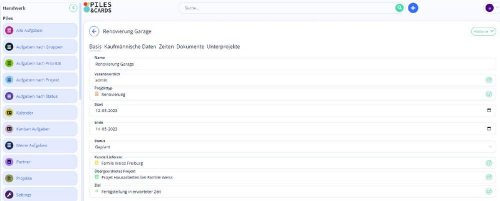
Targeted personnel planning
Pain points in workforce planning: challenges and solutions
Workforce planning is a crucial aspect of a company’s success, but many organisations face challenges that affect the efficiency and effectiveness of this process.
Considering corporate strategy and HR planning together at an early stage
One common difficulty is that HR planning is not sufficiently aligned with the overarching corporate and HR objectives. This can lead to a lack of coherence and effectiveness, as resources may not be optimally aligned with strategic priorities. Furthermore, recruitment is often perceived as a reactive process that arises in the midst of challenges and needs, rather than being approached proactively and with foresight. However, personnel requirements planning should be carried out at an early stage in order to optimally align workforce planning with it.
Integrated personnel planning strategy needs more than Excel
If Excel is used for personnel planning, for example, manual data preparation and planning steps often lead to a considerable amount of time and work. This not only impairs efficiency, but also increases the risk of errors. Different planning files or even complex formulas lead to a lack of transparency in the planning process itself and the resulting outcomes. In addition, isolated and non-integrated planning processes can lead to inconsistencies and inefficient use of resources. The creation of a consistent, integrated personnel planning strategy is the decisive task in order to utilise synergies and avoid silo mentalities. Furthermore, knowledge of manual workforce planning is often limited to a few experts, which can lead to bottlenecks and dependencies. Creating a broader understanding and distribution of knowledge within the team is crucial to ensure continuity and efficiency.
In addition to quantity and quality: consider key factors in workforce planning
When it comes to workforce planning, the consideration of key factors is often overlooked. However, this is an important step when it comes to achieving the company’s objectives and the personnel targets derived from them. Otherwise, it is possible that planned measures will only make an inadequate contribution to the sustainable achievement of objectives, e.g. because the specifics of the target group are unknown. In addition, a purely quantitative approach to recruitment neglects qualitative aspects such as employee development. A balanced relationship between quantitative and qualitative criteria is crucial to ensure long-term success.
To overcome these pain points, a strategic reorientation of HR planning is required. This includes
- the integration of technologies,
- the consideration of qualitative aspects,
- the promotion of transparent communication and
- the development of a proactive approach that focuses on the company’s long-term goals and tasks.
Components of targeted HR planning for sustainable business success
Effective HR planning is essential to achieve business goals and fulfil the needs of employees. Targeted HR planning comprises various components that interlock seamlessly to ensure optimal resource utilisation and employee development. Well thought-out HR controlling is an effective key and the solution for effective HR planning.
Corporate and HR goals:
The basis of any targeted HR planning lies in a clear alignment with the company’s goals. This requires a deep understanding of the company’s long-term vision and strategic priorities. The HR objectives must reflect these overarching corporate goals to ensure that all activities work towards a common vision.
Staffing requirements planning (top-down planning):
Top-down planning is crucial to anticipate future staffing requirements and initiate appropriate measures. This involves translating the company’s objectives into specific personnel requirements. These forecasts make it possible to provide suitable employee resources in good time and avoid bottlenecks.
Staffing analysis:
Analysing the current workforce is a fundamental component of understanding the current situation. This involves assessing the skills, qualifications and experience of employees. This analysis serves as a starting point for identifying gaps and targeted staff development.
Quantitative and qualitative gap analysis:
The quantitative gap analysis refers to the comparison between the current workforce and the projected future demand for staff. The qualitative gap analysis goes beyond this and also looks at skills, competences and potential professional bottlenecks. This analysis allows targeted measures to be taken to bridge gaps.
Key factor analysis:
A thorough analysis of the key factors that influence staffing requirements is crucial. In addition to aspects such as technological developments, demographic changes, market trends and organisational changes, this also includes an analysis of the specific target groups on which the planned HR measures are intended to have an impact. The identification and consideration of these specifics enables forward-looking HR planning that includes optimised measures to achieve the objectives.
The successful integration of these components not only ensures effective HR planning, but also helps to create an adaptable organisation. The cornerstones of sustainable and targeted personnel development are
- continuous harmonisation between corporate and personnel objectives,
- proactive personnel requirements planning,
- the ongoing analysis of the workforce,
- quantitative and qualitative gap analyses and
- Regularly analysing key factors and target group specifics.
- Software-based plan/actual comparisons on an automated database
With suitable support from software that is based on an automated central database, this control loop does not come to a standstill and the planned/actual comparisons are available with minimal effort.
Decision-making process in personnel planning: integration of gap analysis and key factor analysis enables transparent scenarios and well-founded personnel cost calculation
In order for the right decisions to be made within personnel planning for the optimal use of resources, it should be based on a comprehensive analysis as a dynamic process. In a well thought-out decision-making process, the results of the GAP analysis and the key factor analysis are incorporated into various planning scenarios. These scenarios make it possible to compare different personnel measures, such as recruitment, training and others, in order to carry out a well-founded cost calculation of personnel on this basis.
Read the full article on nc360°, the noventum information platform:
- Planning scenarios enable cost calculation
- Automated tools for targeted personnel planning strengthen corporate goals
Or download the noventum HR Planning information brochure free of charge!
noventum consulting GmbH is an international IT management consultancy.
Founded in 1996 in Münster, today noventum is represented in Münster and Düsseldorf with more than 120 employees. An independent noventum partner company works in Luxembourg.
The managing partner is Uwe Rotermund.
noventum consulting supports its customers in their IT challenges and in their efforts for a modern corporate culture.
Customers are DAX companies as well as medium-sized companies and organizations with a large IT infrastructure.
noventum consulting GmbH
Münsterstraße 111
48155 Münster
Telefon: +49 (2506) 9302-0
Telefax: +49 (2506) 9302-23
http://www.noventum.de
Redaktion/Presse
Telefon: +49 (2506) 9302-0
E-Mail: matthias.rensing@noventum.de
Solution Lead HR Planning
![]()



